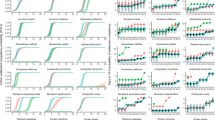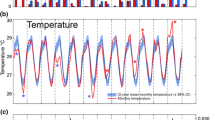Abstract
Coral reefs are predicted to be vulnerable to the Allee effect due to the density dependence of broadcast spawning fertilisation success. Verifying such effects in corals, however, is hindered by their annual or biannual nocturnal multispecific synchronous spawning events, the lack of colony spatial distribution data, and the difficulty of manipulating coral colony density in the field. These obstacles were overcome by simulating scleractinian coral spawning events at various distances between colonies. While controlling for density, and including the influence of colony size and current flow speed, we investigated the distance at which reproductive contact became unlikely (critical intercolonial distance). The relationship between fertilisation success and colony density was also examined by simulating broadcast spawning events at different densities, with the aim of investigating whether Allee effects can occur at population densities observed in the literature. Fertilisation events rarely occurred between simulated coral colonies that were more than 30–40 m apart in the conditions tested due to sperm dilution and insufficient mixing between gametes from different colonies. Higher flow speeds improved mixing for distant colonies but generally resulted in low fertilisation success; larger colonies reduced the impact of dilution due to increased reproductive output. Fertilisation success exhibited a logarithmic relationship as colony density increased (e.g. 99.0% at 3.36 × 10−2 colonies m−2 for colonies with 1 m2 surface area), with low fertilisation success (21.0% at 2.70 × 10−3 colonies m−2 for 1 m2 colonies) at densities comparable to post-disturbance populations. These findings suggest the potential for strong component Allee effects due to broadcast spawning. Our critical intercolonial distance results support existing evidence that coral populations within a reef may consist of multiple breeding groups instead of a single homogeneous one. The inclusion of spatial data when surveying for coral colony density should be considered when attempting to predict density dependent effects.







Similar content being viewed by others
References
Adjeroud M, Pratchett MS, Kospartov MC, Lejeusne C, Penin L (2007) Small-scale variability in the size structure of scleractinian corals around Moorea, French Polynesia: patterns across depths and locations. Hydrobiologia 589:117–126
Alino PM, Coll JC (1989) Observations of the synchronized mass spawning and post settlement activity of octocorals on the Great Barrier Reef, Australia: biological aspects. Bull Mar Sci 45:697–707
Álvarez-Noriega M, Baird AH, Dornelas M, Madin JS, Cumbo VR, Connolly SR (2016) Fecundity and the demographic strategies of coral morphologies. Ecology 97:3485–3493
Ayre DJ, Hughes TP (2000) Genotypic diversity and gene flow in brooding and spawning corals along the Great Barrier Reef, Australia. Evolution (N Y) 54:1590–1605
Babcock RC, Heyward AJ (1986) Larval development of certain gamete-spawning scleractinian corals. Coral Reefs 5:111–116
Babcock RC, Mundy CN, Whitehead D (1994) Sperm diffusion models and in situ confirmation of long-distance fertilization in the free-spawning asteroid Acanthaster planci. Biol Bull 186:17–28
Baird AH, Guest JR, Willis BL (2009) Systematic and biogeographical patterns in the reproductive biology of scleractinian corals. Annu Rev Ecol Evol Syst 40:551–571
Baird ME, Atkinson MJ (1997) Measurement and prediction of mass transfer to experimental coral reef communities. Limnol Oceanogr 42:1685–1693
Chui APY, Wong MC, Liu SH, Lee GW, Chan SW, Lau PL, Leung SM, Ang P (2014) Gametogenesis, embryogenesis, and fertilization ecology of Platygyra acuta in marginal nonreefal coral communities in Hong Kong. J Mar Biol 2014:1–9
Claereboudt M (1999) Fertilization success in spatially distributed populations of benthic free-spawners: a simulation model. Ecol Modell 121:221–233
Coma R, Lasker HR (1997) Small-scale heterogeneity of fertilization success in a broadcast spawning octocoral. J Exp Mar Bio Ecol 214:107–120
Courchamp F, Berec L, Gascoigne J (2008) Allee effects in ecology and conservation. Environ Conserv 36:80–85
Fan TY, Dai CF (1998) Sexual reproduction of the scleractinian coral Merulina ampliata in southern Taiwan. Bull Mar Sci 62:897–904
Fuchs EJ, Robles T, Hamrick JL (2013) Spatial distribution of Guaiacum sanctum (Zygophyllaceae) seedlings and saplings relative to canopy cover in Palo Verde National Park, Costa Rica. Rev Biol Trop 61:1521–1533
Gascoigne J, Lipcius RN (2004) Allee effects in marine systems. Mar Ecol Prog Ser 269:49–59
Gittings SR, Boland GS, Deslarzes KJ, Combs CL, Holland BS, Bright TJ (1992) Mass spawning and reproductive viability of reef corals at the East Flower Garden Bank, northwest Gulf of Mexico. Bull Mar Sci 51:420–428
Harrison PL, Babcock RC, Bull GD, Oliver JK, Wallace CC, Willis BL (1984) Mass spawning in tropical reef corals. Science 223:1186–1189
Hughes TP, Kerry JT, Álvarez-Noriega M, Álvarez-Romero JG, Anderson KD, Baird AH, Babcock RC, Beger M, Bellwood DR, Berkelmans R, Bridge TC, Butler IR, Byrne M, Cantin NE, Comeau S, Connolly SR, Cumming GS, Dalton SJ, Diaz-Pulido G, Eakin CM, Figueira WF, Gilmour JP, Harrison HB, Heron SF, Hoey AS, Hobbs JPA, Hoogenboom MO, Kennedy EV, Kuo C, Lough JM, Lowe RJ, Liu G, McCulloch MT, Malcolm HA, McWilliam MJ, Pandolfi JM, Pears RJ, Pratchett MS, Schoepf V, Simpson T, Skirving WJ, Sommer B, Torda G, Wachenfeld DR, Willis BL, Wilson SK (2017) Global warming and recurrent mass bleaching of corals. Nature 543:373–377
IFH (n.d.) 3. Mixing in Rivers: Turbulent Diffusion and Dispersion. Karlsruhe Institute of Technology. http://www.ifh.uni-karlsruhe.de/lehre/envflu_i/Downloads/course_script/ed2/ch3.PDF
Iguchi A, Morita M, Nakajima Y, Nishikawa A, Miller D (2009) In vitro fertilization efficiency in coral Acropora digitifera. Zygote 17:225–227
Jackson JBC, Buss L (1975) Alleopathy and spatial competition among coral reef invertebrates. Proc Natl Acad Sci U S A 72:5160–5163
Kennedy EV, Perry CT, Halloran PR, Iglesias-Prieto R, Schönberg CH, Wisshak M, Form AU, Carricart-Ganivet JP, Fine M, Eakin CM, Mumby PJ (2013) Avoiding coral reef functional collapse requires local and global action. Curr Biol 23:912–918
King B, Wolanski E (1996) Tidal current variability in the central Great Barrier Reef. J Mar Syst 9:187–202
Levitan DR (1998) Sperm Limitation, Gamete Competition, and Sexual Selection in External Fertilizers. In: Birkhead TR, Møller AP (eds) Sperm Competition and Sexual Selection. Academic Press, California, pp 175–218
Levitan DR, Young CM (1995) Reproductive success in large populations: empirical measures and theoretical predictions of fertilization in the sea biscuit Clypeaster rosaceus. J Exp Mar Bio Ecol 190:221–241
Levitan DR, Fukami H, Jara J, Kline D, McGovern TM, McGhee KE, Swanson CA, Knowlton N (2004) Mechanisms of reproductive isolation among sympatric broadcast-spawning corals of the Montastraea annularis species complex. Evolution 58:308–323
Majda AJ, Kramer PR (1999) Simplified models for turbulent diffusion: theory, numerical modelling, and physical phenomena. Phys Rep 314:237–574
Metaxas A, Scheibling RE, Young CM (2002) Estimating fertilization success in marine benthic invertebrates: a case study with the tropical sea star Oreaster reticulatus. Mar Ecol Prog Ser 226:87–101
Millar RB, Anderson MJ (2003) The kinetics of monospermic and polyspermic fertilization in free-spawning marine invertebrates. J Theor Biol 224:79–85
Miller K, Babcock R (1997) Conflicting morphological and reproductive species boundaries in the coral genus Platygyra. Biol Bull 192:98–110
Morita M, Nishikawa A, Nakajima A, Iguchi A, Sakai K, Takemura A, Okuno M (2006) Eggs regulate sperm flagellar motility initiation, chemotaxis and inhibition in the coral Acropora digitifera, A. gemmifera and A. tenuis. J Exp Biol 209:4574–4579
Nozawa Y, Isomura N, Fukami H (2015) Influence of sperm dilution and gamete contact time on the fertilization rate of scleractinian corals. Coral Reefs 34:1199–1206
Oliver J, Babcock R (1992) Aspects of the fertilization ecology of broadcast spawning corals: sperm dilution effects and in situ measurements of fertilization. Biol Bull 183:409–417
Pratchett MS, Gust N, Goby G, Klanten SO (2001) Consumption of coral propagules represents a significant trophic link between corals and reef fish. Coral Reefs 20:13–17
Ray C, Hastings A (1996) Density dependence: are we searching at the wrong spatial scale? J Anim Ecol 65:556–566
Ricardo GF, Jones RJ, Clode PL, Humanes A, Negri AP (2015) Suspended sediments limit coral sperm availability. Sci Rep 5:18084
Ricardo GF, Jones RJ, Negri AP, Stocker R (2016) That sinking feeling: Suspended sediments can prevent the ascent of coral egg bundles. Sci Rep 6:21567
Roberts CM, McClean CJ, Veron JE, Hawkins JP, Allen GR, McAllister DE, Mittermeier CG, Schueler FW, Spalding M, Wells F, Vynne C, Werner TB (2002) Marine biodiversity hotspots and conservation priorities for tropical reefs. Science 295:1280–1284
Shlesinger Y, Loya Y (1991) Larval development and survivorship in the corals Favia favus and Platygyra lamellina. In: Williams RB, Cornelius PFS, Hughes RG, Robson EA (eds) Coelenterate Biology: Recent Research on Cnidaria and Ctenophora. Springer Netherland, Netherlands, pp 101–108
Stephens PA, Sutherland WJ, Freckleton RP (1999) What is the Allee effect? Oikos 87:185–190
Storlazzi CD, Brown EK, Field ME (2006a) The application of acoustic Doppler current profilers to measure the timing and patterns of coral larval dispersal. Coral Reefs 25:369–381
Storlazzi CD, McManus MA, Logan JB, McLaughlin BE (2006b) Cross-shore velocity shear, eddies and heterogeneity in water column properties over fringing coral reefs: West Maui. Hawaii. Cont Shelf Res 26:401–421
Styan CA (1998) Polyspermy, egg size, and the fertilization kinetics of free-spawning marine invertebrates. Am Nat 152:290–297
Teo A, Guest JR, Neo ML, Vicentuan K, Todd PA (2016) Quantification of coral sperm collected during a synchronous spawning event. PeerJ 4:e2180
van Woesik R, Sakai K, Ganase A, Loya Y (2011) Revisiting the winners and the losers a decade after coral bleaching. Mar Ecol Prog Ser 434:67–76
Vella D, Mahadevan L (2005) The “cheerios effect”. Am J Phys 73:817–825
von Karman T (1931) Mechanical similitude and turbulence. California Institute of Technology http://authors.library.caltech.edu/47900/
Warner PA, Willis BL, van Oppen MJ (2016) Sperm dispersal distances estimated by parentage analysis in a brooding scleractinian coral. Mol Ecol 25:1398–1415
Wehenkel C, Brazão-Protázio JM, Carrillo-Parra A, Martínez-Guerrero JH, Crecente-Campo F (2015) Spatial Distribution Patterns in the Very Rare and Species-Rich Picea chihuahuana Tree Community (Mexico). PloS One 10:e0140442
Whitaker K (2004) Non-random mating and population genetic subdivision of two broadcasting corals at Ningaloo Reef, Western Australia. Mar Biol 144:593–603
Willis BL, Babcock RC, Harrison PL, Wallace CC (1997) Experimental hybridization and breeding incompatibilities within the mating systems of mass spawning reef corals. Coral Reefs 16:S53–S65
Acknowledgements
Many thanks to James Guest and Roman Carrasco for advice on coral reproduction and modelling respectively, Ang Chiam Foong Ambert for the Merulina ampliata drawing, as well as the support of the Experimental Marine Ecology Laboratory. We would also like to thank the two reviewers for their excellent comments and suggestions. This research is supported by the National Research Foundation, Prime Minister’s Office, Singapore under its Marine Science Research and Development Programme (MSRDP-P05).
Author information
Authors and Affiliations
Corresponding author
Additional information
Topic Editor Anastazia Banaszak
Electronic supplementary material
Below is the link to the electronic supplementary material.
Rights and permissions
About this article
Cite this article
Teo, A., Todd, P.A. Simulating the effects of colony density and intercolonial distance on fertilisation success in broadcast spawning scleractinian corals. Coral Reefs 37, 891–900 (2018). https://doi.org/10.1007/s00338-018-1715-9
Received:
Accepted:
Published:
Issue Date:
DOI: https://doi.org/10.1007/s00338-018-1715-9




